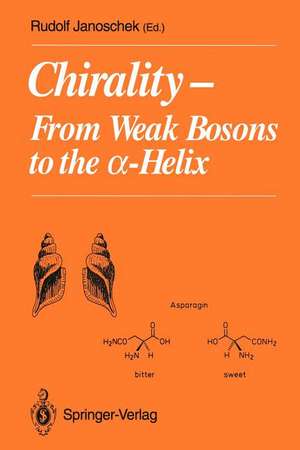Chirality: From Weak Bosons to the ?-Helix
Editat de Rudolf Janoscheken Limba Engleză Paperback – 23 dec 2011
Preț: 386.22 lei
Nou
Puncte Express: 579
Preț estimativ în valută:
73.91€ • 79.03$ • 61.62£
73.91€ • 79.03$ • 61.62£
Carte tipărită la comandă
Livrare economică 17 aprilie-01 mai
Preluare comenzi: 021 569.72.76
Specificații
ISBN-13: 9783642765711
ISBN-10: 3642765718
Pagini: 264
Ilustrații: XI, 246 p. 24 illus.
Dimensiuni: 155 x 235 x 14 mm
Greutate: 0.37 kg
Ediția:Softcover reprint of the original 1st ed. 1991
Editura: Springer Berlin, Heidelberg
Colecția Springer
Locul publicării:Berlin, Heidelberg, Germany
ISBN-10: 3642765718
Pagini: 264
Ilustrații: XI, 246 p. 24 illus.
Dimensiuni: 155 x 235 x 14 mm
Greutate: 0.37 kg
Ediția:Softcover reprint of the original 1st ed. 1991
Editura: Springer Berlin, Heidelberg
Colecția Springer
Locul publicării:Berlin, Heidelberg, Germany
Public țintă
ResearchCuprins
1 Parity Violation in Atomic Physics.- 1.1 Introduction.- 1.2 Parity.- 1.3 Elementary Particles and Forces.- 1.4 Parity-Violating Effects in Atoms.- 1.5 References.- 2 Theories on the Origin of Biomolecular Homochirality.- 2.1 Introduction.- 2.2 Observability of Chiral Molecular Structures.- 2.3 Kinetic Models for Unstable Equilibrium.- 2.4 Kinetic Models with Instrinsic Asymmetry.- 2.5 Parity-Violating Energy Differences Between Enantiomers.- 2.6 Homochirality from Stochastic Equations.- 2.7 References.- 3 Chirality and Group Theory.- 3.1 Introduction.- 3.2 The Principle of Pairwise Interactions.- 3.3 The Theory of Chirality Functions.- 3.4 The Approximation Methods.- 3.5 Determining the Lowest-Degree Chirality Polynomials.- 3.6 Qualitative Completeness and Supercompleteness.- 3.7 Counting Enantiomeric Pairs.- 3.8 References.- 4 Helicity of Molecules — Different Definitions and Application to Circular Dichroism.- 4.1 Introduction.- 4.2 The Ideal Finite Helix.- 4.3 Real Molecules or Parts of Them, Fractions of a Helix.- 4.4 Rules.- 4.5 Some Applications.- 4.6 Summary.- 4.7 References.- 5 Anomalous Dispersion of X-Rays and the Determination of the Handedness of Chiral Molecules.- 5.1 Introduction.- 5.2 “Normal” X-Ray Diffraction.- 5.3 Past, Presence and Future Use of Anomalous Scattering.- 5.4 References.- 6 Chirality in Organic Synthesis — The Use of Biocatalysts.- 6.1 Chirality in Organic Chemistry and Biochemistry.- 6.2 Biocatalysts in Organic Chemistry — General Remarks.- 6.3 Enzymes.- 6.4 Use of Whole Cell Systems.- 6.5 Application of Biocatalytic Hydrolysis.- 6.6 Reduction and Oxidation Using Biocatalysts.- 6.7 Further Applications.- 6.8 Special Techniques and Novel Developments.- 6.9 Comparison of Methods and Outlook.- 6.10 References.- 7 Preparation ofHomochiral Organic Compounds.- 7.1 Introduction.- 7.2 Separation Techniques.- 7.3 Homochiral Building Blocks from Natural Products.- 7.4 Auxiliary Modified Substrates.- 7.5 Homochiral Reagents.- 7.6 Homochiral Catalysts.- 7.7 References.- 8 Transition Metal Chemistry and Optical Activity — Werner-Type Complexes, Organometallic Compounds, Enantioselective Catalysis.- 8.1 Werner-Type Complexes.- 8.2 Organometallic Compounds.- 8.3 Enantioselective Catalysis with Optically Active Transition Compounds.- 8.4 References.- 9 Strategies for Liquid Chromatographic Resolution of Enantiomers.- 9.1 Background of Basic Chromatorgraphic Terms.- 9.2 Strategies to Separate Enantiomers by Chromatographic Techniques.- 9.3 Thermodynamic and Kinetic Considerations for Chromatographic Enantioseparation.- 9.4 Enantioselective Liquid Chromatography.- 9.5 Direct Enantioseparation by Liquid Chromatography.- 9.6 Chiral Phases Using Polymers as Chiral Selectors.- 9.7 Chiral Stationary Phases Using Proteins (Polypeptides) as Chiral Selectors.- 9.8 Chiral Stationary Phases Based on Synthetic Chiral Polymers.- 9.9 Chiral Stationary Phases Based on “Brush Type” Immobilization of Small Selector Molecules.- 9.10 Final Remarks on Brush Type and Inclusion Type CSPs.- 9.11 Indirect Enantioseparation.- 9.12 Final Remarks.- 9.13 References.- 10 The Nucleoproteinic System.- 10.1 Introduction.- 10.2 The Chiral Message.- 10.3 The Evolution of the Chiral Amphiphilic Patterns.- 10.4 Stabilization Within the Dynamics.- 10.5 Outlook.- 10.6 References.









